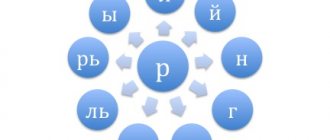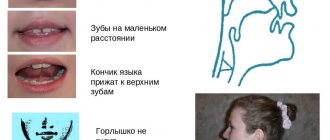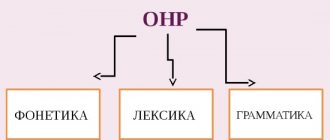Speech defects can vary. You can often find incorrect pronunciation of sounds, for example, replacing one with another. In this case, instead of “sledge” you will hear “shanki”. Children find it most difficult to pronounce the sound “R”. Many parents notice that their baby cannot really growl, and try to teach him.
After such actions, distorted reproduction is often formed. Normally, the tip of the tongue vibrates, but if the pronunciation is incorrect, it is the throat that vibrates. As a result, the so-called “French” sound is heard. Producing the sound “R” in throat pronunciation requires special techniques from the speech therapist.
general information
Parents may not always correctly notice distorted pronunciation. It is formed for various reasons. Most often the problem is in the short hypoglossal ligament. It attaches the tongue to the oral cavity and if it is not long enough, the mobility of the organ is limited.
The following congenital anatomical features may also be observed:
- high sky;
- narrow sky;
- massive tongue.
Sometimes replacing the front milk teeth with molars can take a long time and this will lead to incorrect pronunciation. Somatically weakened children who often suffer from colds may experience weak breathing and lethargy. Their tongue will move and rise poorly. Due to the lack of a strong air stream, it will not be possible to cause vibration.
Another reason for throaty pronunciation is early learning of a foreign language.
Some parents, from the age of three, begin to teach their child French or English, without taking into account the difference between the pronunciation of sounds.
Correcting such a defect will take a lot of time. It's easier to add sound when it is completely absent from speech. If it is pronounced distortedly, then you will have to make a lot of effort to correct the situation.
Throat pronunciation is difficult to correct due to insufficient development of phonetic-phonemic perception. The child gets used to hearing the defective sound and cannot distinguish it from the normal one. Therefore, attempts to introduce the correct sound into speech may end in failure.
When and how to start
Therefore, if you or the child himself decides that something needs to be done about this, then you need to do it right away! Speech therapists say that the throat “r” is one of the most difficult problems that is problematic to eliminate. The sooner you start, the better. In adults, this defect cannot be cured, but in a child, correction can take a lot of time and require a fair amount of effort.
Of course, it's not all that bad. It happens that a speech therapist corrects the laryngeal “r” quite quickly, literally in a month or two, and in exceptional cases – in just a few sessions. But it is a mistake to think that “it will go away on its own.” It itself goes away extremely rarely, experts say, and it is better not to delay the elimination of this defect.
Important points
Before you start working on sound correction, you need to consider some nuances. A thorough diagnosis is required. Some parents may only notice problems with the pronunciation of "R" but not the rest. Be sure to check:
- vocabulary;
- grammar;
- speech hearing.
The speech therapist also looks at the structure of the articulatory apparatus - lips, jaws, palate. During such a check, erased dysarthria can be detected. It is characterized by impaired muscle tone (they are too weak or too tense), weak breathing.
With dysarthria, the tongue may be bunched up in the mouth or lie completely limp against the teeth.
In this case, additional speech therapy massage and drug treatment will be required. Due to tone problems, problems with sound automation may occur.
Checking whether your pronunciation is throaty is quite simple. You need to ask to growl with your mouth open. If it really is in the throat, then the child will be able to do it.
Causes of guttural "r"
It would seem that in an environment where everyone says “r” correctly, the child should also pronounce it the same way. But this sound is insidious and difficult for children, it is not for nothing that it is most often replaced with “l”, “f” and even “d”. Why does the baby use the throat “r”?
There are different reasons. First of all - “heredity”. If one parent says the guttural “r” and the child hears it all the time, he may begin to repeat it.
A short “frenulum” under the tongue makes it inactive and prevents you from pronouncing sounds correctly. Usually this defect is removed at very different ages, but it can also be neglected.
Often the cause of the laryngeal “r” is enlarged tonsils. It is easier for a child to close the root of the tongue with the palate than to use its tip.
There are also more complex situations: nervous disorders, impaired phonemic hearing, hypotonicity of the tongue and much more. Fortunately, all this can be treated, and a defect in the throat “r” in a child can always be corrected if you contact an experienced specialist. The question is how much time and effort it will take.
If you wish, you can diagnose the causes of the laryngeal “r”, so it will be easier to deal with them. However, this is not the most important thing, since unless we are talking about serious illnesses, speech therapists use the same exercises in most cases.
Preparatory stage
For the correction to be successful, it must be carried out in stages. The first stage lays the foundation for the correct sound. During the lesson, the child will practice the correct pronunciation model:
- the mouth smiles widely;
- teeth exposed;
- the tip of the tongue rests on the tubercles behind the upper teeth.
For ease of perception, a graphic representation of articulation is shown. As you work, you will notice that children are not always able to easily make their tongue wide. The tip may be constantly narrowed and tense.
In this case, practice the “knead the dough” exercise with them. You need to put the tongue on your lower lip and lightly bite it with your teeth. They accompany the movement with the syllabic path “pa-pa-pa-pa”.
Gradually, the child’s attention is focused on changes in the state of the language. After the exercise it became wide. All training is carried out in front of a mirror, since without visual control they are useless.
During the lesson they learn a complex of articulatory gymnastics. This will allow you to prepare the device for sound production. The standard set includes exercises to develop a strong tip of the tongue.
In individual lessons, special cards with symbols are used. They are needed for ease of perception on the part of the child. For example, a picture of a horse invites him to clatter, but this should be done as follows:
- mouth wide open;
- tongue touches the roof of the mouth;
- the jaw is motionless.
For the whole complex, it is important that only the tongue works, the jaw should not move. They also use the “clock” exercise - the starting position is the same as in the “horse”, only the tongue moves left and right. It should not touch lips and teeth! In the “swing” exercise, the position is the same, but the tongue moves up and down.
To make it easier for the child to lift the tip of the tongue, use the following exercise: take thin strips of toffee and ask the tongue to fasten them on the tubercles behind the upper teeth. It is useful to lick honey, sour cream from a plate, lick fruit ice and other frozen ice cream and candies.
Breathing exercises
It's not so easy to remove throaty pronunciation. In order to get rid of it you need a strong air stream. To produce it, you need plumes, wind blowers, feathers, etc. The child must sit and blow on them. His cheeks should not puff up - this moment is strictly controlled.
Approximate instructions: inhale strongly through your nose and exhale through your lips with a straw. To make it interesting for children to study, small competitions are held. Hex pencils are placed on the table and asked to be blown away. Whoever is the farthest wins. Preschoolers will be delighted with this activity.
Auditory perception
The key point of correctional work is to teach the child to listen to his own speech and notice errors in it. This is the only way to get rid of throaty pronunciation.
To develop hearing, non-speech sounds are used: street noise, door slamming, etc. You can use musical instruments. The child is shown how and what he plays, asked to remember, then he turns away and determines the action by ear.
Later they move on to distinguishing sounds and, to begin with, take only vowels. Gradually they learn to determine the place of sound in a word.
Do not confuse the concepts of “letter” and “sound”. These are different systems. Before school or preschool, it is better not to give your child anything related to letters.
All these complexes must be practiced at home. Otherwise there will be no effect from such a production.
Staging the sound R in stages by a speech therapist in children
Speech therapy massage for sound production [r]. It is used for disorders of tongue muscle movements. The massage is performed with special sterile instruments: speech therapy probes. Only a teacher-speech therapist should perform a massage, since you need to know that the type of massage depends on the dysfunction of the motor functions of the muscles. In some cases, a relaxing massage is needed, and in others, a tonic one.
The mixing of the sound [p] is manifested by constant replacements with other sounds. In this case, the phonemes [р] and [рь] are pronounced in isolation correctly. The child may growl, but when pronouncing words with these sounds, he constantly replaces them with other phonemes. This disorder indicates underdevelopment of phonemic hearing processes. This form of disorder involves the consolidation of the sounds [р] and [рь] in speech, and the development of phonemic hearing.
Methods of causing sound
After the preparatory stage has been worked out and the children can do everything well, they move directly to sound production. When pronunciating in the throat, it is advisable to achieve a proto (non-vibrating) “R” sound.
In front of the mirror, the child is asked to smile broadly, raise the tip of his tongue to the desired position and pronounce the sound “Z”. It will sound distorted and this is called a “broken bell”. Vowels are added to it and you get a growl, but without vibration.
The resulting sound can be immediately automated into syllables.
It is necessary that the child hears the difference in pronunciation well and can control himself.
You can try to create vibration. To do this, take a special probe (a stick with a small ball) and swing the tongue during pronunciation. With regular exercise, there will be no need for mechanical assistance.
Sometimes it is effective to use the machine gun exercise. The tip of the tongue hits the tubercles and is accompanied by the pronunciation of the sound “D”. Gradually, the movements speed up and with a strong exhalation, the desired rumble is heard. To facilitate perception, the combination “DR” or “TR” is introduced. Vowels are added to them and this combination is automated.
When to contact a specialist
As the speech therapist told us, the articulatory apparatus is fully formed by the age of four to five years. And if by this time the child does not pronounce the hard sound “r” and the soft “ry”, then this may be a good reason to contact a specialist. She clarified that the sound “r” is considered one of the most difficult and its production requires preparatory work.
Now we will explain why the sound is complex. If you remember your school years and Russian language lessons, then you will probably remember a sign with voiced and voiceless consonants. But “r” always stood in a separate column - sonorant sounds. They were the ones who did not have a deaf pair and were distinguished by the fact that they were pronounced with a distinct and ringing expression in the voice. According to statistics, preschoolers at the age of four can pronounce all sounds except sonorant ones.
What happens when we pronounce the sound "r"? Here's what:
• lips are in a relaxed state;
• a space of four to five millimeters is formed between the teeth;
• the tip of the tongue at this time rises to the upper gums;
• due to the flow of air, the tongue begins to vibrate;
• the middle part of the tongue arches, and the back, on the contrary, is pressed against the palate;
• along the edges of the tongue is pressed against the upper teeth;
• vocal folds fluctuate at the moment of pronunciation.
Therefore, the following types of pronunciation are considered deviations from the norm and necessarily require correction by a qualified specialist:
• Velar - the tip of the tongue moves down during pronunciation and does not take part in articulation. There is a lot of tension in the tongue itself, causing it to move back. The pronunciation itself occurs not with the help of the voice, but with the help of air, which means the sound is guttural;
• Uvular - the tongue begins to vibrate in the resulting stream of air. The sound is very quiet and soft;
• Nasal - from the name you can understand how the sound itself is produced. This pronunciation is characterized by localization of air in the nose and a complete absence of vibration;
• Bilabial - in this case, only the lips take part in the formation of sounds, the tongue is not involved in any way;
• Slit - the tongue is directed upward, when speaking it forms a gap with the soft palate;
• Interdental - the tongue is located between the teeth, due to which the pronounced sounds are greatly distorted.
From the personal archive of Vita Bilukha /
Introduction to Speech
Eliminating incorrect pronunciation is a long process and takes time. On average, it takes up to a year to correct the defect. The help of parents also plays a big role. If they are interested, they will study daily.
Adults can also be burry. And the same methods of sound production apply to them. It will take serious motivation to cope with a speech impediment.
Sometimes parents do not understand why they should force their child to speak correctly. His future career depends on this. Many professions have standards and people with defects will not be hired.
It will take a long time to introduce sound into speech. At this stage, it is important to engage self-control. It is necessary to correct the child, force him to remember the correct pronunciation. It is useful to learn rhymes, simple sayings, tongue twisters.
Correction of any defect directly depends on the coordinated work of a specialist and parents. Only together can they cope with the problem. The faster a child learns articulatory gymnastics and begins to perform it perfectly, the sooner a sound will be given to him.
How to correct a child’s throat “r” and whether it should be done
Often, when children begin to speak, at some point they use the guttural “r” instead of the normal one. Parents do not pay attention to this, expecting that later everything will get better on its own. All other sounds soon sound correct. But the throaty “r” is in no hurry to leave. And only at school do parents come to their senses and take the child to a speech therapist. And he exclaims: “Where have you been before?”
But many parents do not try to correct the throaty “r” to a normal one. They think it’s even piquant and sounds French. Only the French pronounce their “r” completely differently. And if you are planning to teach your child French (which, of course, is wonderful!), then no one has canceled their native Russian.
Parents' admiration disappears when classmates begin to tease the child, calling him “bad,” or when the teacher makes it clear that something needs to be done about the problem. So is it still necessary or not?









